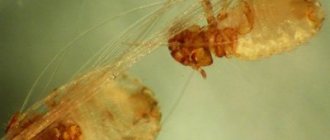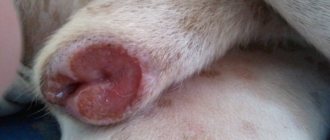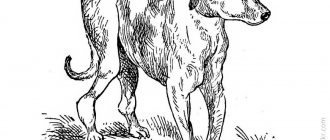Distemper (Pestis) is a highly contagious viral disease characterized by fever, intoxication, damage to the skin and mucous membranes, respiratory and digestive organs in dogs. In some cases, it causes severe manifestations of meningitis and encephalitis.
Distemper has been known since the domestication of dogs. In the writings of Aristotle it is described as a sore throat. In Russia, it appeared in 1762 in Crimea and was called the “Crimean disease.” The viral nature of the plague was first proven in 1905 by the French scientist Carré (Carré disease).
Causes of distemper in dogs
The development of distemper in dogs occurs for one, only reason - the penetration into the animal’s body of a highly contagious virus belonging to the paramyxovirus family. It is characterized by the following features:
- capable of very rapid reproduction;
- has a strong pathogenic effect on the body;
- can affect several organ systems at once or a specific one;
- remains active in the physiological secretions of a sick dog for a week, and under favorable conditions, even more.
Once the virus enters the animal’s body, the dog itself becomes its carrier and source of infection.
Can I switch to a cat?
The causative agents of canine distemper are absolutely safe for cats. This point greatly facilitates the diagnosis of the disease; if both animals live in the same area and suddenly feel unwell, then distemper is immediately ruled out.
Attention! Don't forget about infections that may occur during illness. Be sure to separate dishes, bedding, etc. until the animal is completely restored.
What about the other way around?
The feline distemper virus is safe for dogs. They cannot become infected from each other, since the causative agents of the disease are different. A dog also cannot get sick directly from a person unless for an indirect reason, for example, the virus was brought on outer clothing or shoes.
Where can a dog get distemper?
A dog infected with distemper. Note the purulent discharge and hyperkeratotic nose.
A dog can become infected with distemper anywhere, even at home. The source of infection is the secretions of another animal - a carrier of the virus. The virus can enter the body of a healthy pet in two ways: through the digestive tract and the respiratory system, so almost any object poses a danger, not to mention direct contact with a sick dog. This:
- feces, discharge during estrus, saliva, etc.;
- booth, aviary;
- Bowl;
- litter and so on.
The owner himself can “bring” distemper infection into the house, for example, on shoes. Cats can transmit the virus in the same way if they walk outside but come home to spend the night.
Proper nutrition
Another additional method of prevention is organizing proper nutrition. Your pet's body will need strength to resist the virus, so take care of a balanced diet.
Your pet can get the required amount of protein every day not only from meat, but also from cottage cheese. The daily requirement of dietary vitamins is contained in raw liver, and the dog can get the required amount of iron from semolina. Millet is a source of nicotinic acid, buckwheat is a source of lecithin, etc. In general, food should be varied.
Good advice: do not use only ready-made mixtures and especially dry food in your dog’s diet. Along with ready-made store-bought delicacies, the animal should also receive regular cereals and stews. Such food has a positive effect on digestion. Don't forget about water, especially if dry food is present in the diet.
Mechanism of disease development
After the distemper virus has entered the animal’s body, it begins to actively multiply. The owner will not immediately determine that his pet is sick. The first days the dog is in its normal state. The latent reproduction period of the virus can be an average of a week, but sometimes two or even three. A very rare situation occurs when signs of the disease appear 2-3 days after contact between a healthy and an infected dog. This is only possible if the animal has virtually no immunity.
Note: a dog that has had distemper remains immune to the virus for life.
After the incubation period has passed and the virus has multiplied sufficiently, the first signs of the disease appear.
How is the virus transmitted?
How is a disease that is so dangerous for dogs transmitted? It spreads both by airborne droplets and by vectors, which can be people, other animals and even worms. Never use someone else’s carriers, bedding, or use a used kennel. All belongings of a sick animal must be burned.
The virus can also be transmitted through an already sick animal. Moreover, the dog may look completely healthy, since the disease often has a certain incubation period. For 3-4 months, the recovered animal remains potentially dangerous to other dogs.
If a dog gets sick with distemper, it is necessary to take urgent measures for the animals that have been in contact with it, and also place it in quarantine.
Initial symptoms of canine distemper
How does canine distemper manifest at the initial stage? The most common primary symptoms include:
- lethargy;
- depressed look;
- swelling and redness of the eyes;
- tousled fur;
- sensitivity to light (the dog begins to look for a darker place);
- disorders of the digestive tract;
- mucous discharge from the nose and eyes.
Not all animals exhibit these signs to the same extent. Their severity depends on the state of immunity, lifestyle, age and other factors. In addition, some symptoms of plague may predominate, or others may be added to those listed (for example, increased body temperature). It is also important which organ system is most affected by the virus.
conclusions
Plague is definitely easier to prevent than to treat. Please love your pet and do not neglect vaccinations. Be sure to get vaccinated according to the schedule.
By the way, the clinic will offer you an imported or domestic vaccine. The first one is a little more expensive, but dogs tolerate it better. The second is cheaper, but also harder to learn. The nature of action of the drugs is the same. It makes no sense to get an additional distemper vaccination in isolation from others. As a rule, the necessary substance is already contained in the complex vaccine.
Attention: the above is for educational purposes only and does not constitute professional medical advice or scientific material.
Further development of the disease: forms of plague
Symptoms of distemper in dogs are rarely observed in isolated form, since the virus affects the entire body. However, based on those that are most pronounced, several forms of the disease are conventionally distinguished.
Form
Symptoms
Pulmonary
The animal's body temperature rises and a cough occurs. Discharge from the eyes and nostrils is purulent in nature. The dog refuses to eat and drinks a lot of water. Diarrhea and vomiting gradually develop.
Nervous
The animal is suffering from severe thirst. Muscle twitching is characteristic. Irritability and aggressiveness appear. If left untreated, the hind limbs become paralyzed and epilepsy occurs. When the cardiac and pulmonary muscle fibers are paralyzed, the dog dies.
Intestinal
The pet does not eat, is very weakened, to the point of losing consciousness. The surface of the tongue becomes white due to plaque. The animal suffers from vomiting and diarrhea. In the latter case, the discharge is yellowish.
Skin
Rashes appear on the pet’s body, which later develop into pustules and ulcers. If they become infected, severe inflammation occurs. Despite the fact that this form of the disease is considered the mildest in terms of prognosis, if left untreated, the pet may die from exhaustion.
In addition to classification according to the clinical picture, several forms of distemper in dogs are distinguished based on the duration of the disease.
- Lightning fast. Symptoms hardly appear, but the animal dies within 24 hours.
- Super acute. There is a very high temperature. The animal refuses food. Death occurs on the second or third day.
- Spicy. Characterized by the above symptoms.
- Chronic. Periods of remission alternate with relapses. The duration of the disease is up to several months.
Attention! If any deviations in the behavior or condition of the dog appear, you should immediately contact a veterinarian and get tested.
Diet
We must not forget about special feeding during plague. Food should help boost immunity so that the body can fight harder:
- give more minced meat or finely chopped meat;
- raw egg - twice a week (during illness and during recovery);
- low-fat cottage cheese and kefir;
- broths from meat and vegetables are required; if you cook porridge, then make it liquid, like soup;
- A decoction of motherwort must be poured into drinking water during damage to the nervous system.
Diagnostics
After listening to complaints from the owner and examining the dog externally, the specialist will definitely prescribe laboratory diagnostics. In most cases, the study will require taking blood and swabs from the eyes (nose, mouth).
To identify a virus and determine its type, it is possible to use methods such as:
- enzyme-linked immunosorbent assay (ELISA) – allows you to detect the disease at an early stage;
- polymerase chain reaction (PCR) – also has high sensitivity;
- susceptibility test;
- tests to determine antigen in a dog’s blood;
- neutralization reaction - carried out to determine the species.
Today, there are many other laboratory diagnostic methods that can detect distemper virus in dog tissue. The choice of one method or another is within the competence of the specialist.
Therapeutic measures
Treatment of distemper in dogs is possible only after a comprehensive diagnosis. Due to similar symptoms, it is necessary to separate the disease from other pathologies: parvovirus enteritis, piroplasmosis, rabies, infectious hepatitis, salmonellosis, leptospirosis.
Laboratory tests include blood tests and mucous membrane swabs. Sick animals have a reduced content of lymphocytes.
To detect the virus, enzyme-linked immunosorbent assay (ELISA) and polymerase chain reaction (PCR) are used. ELISA allows you to detect fragments of the viral agent even during the incubation period, and PCR determines its specific type. If a certain form is suspected, an ultrasound or x-ray is performed. These studies are used to understand the extent of damage to internal organs.
Final therapy includes:
- elimination of the pathogen;
- elimination of emerging symptoms;
- restoration of immunity and organs affected by the viral agent.
Injections for dogs against distemper are the only possible method of drug therapy until vomiting is eliminated and the functioning of the gastrointestinal tract is normalized. Oral administration of drugs is not allowed.
“Veterinarians do not give a 100% guarantee of recovery for such a diagnosis.
Due to the many features in therapy, you cannot resort to self-medication. Traditional methods that rely on the healing power of vodka can lead to the death of your pet. When the intestines become infected, the mucous membranes are often affected by ulcers and are very vulnerable to exposure to aggressive elements.
It is also prohibited to use folk recipes based on herbs. They are fraught with allergic reactions, so they are used only as directed and under the supervision of a doctor.
“Drug therapy recommended by veterinarians is expensive and time-consuming. Despite this, it is important to strictly follow the instructions you receive. This is the only way to save your four-legged pet.
In a home with a sick animal, it is necessary to regularly clean the room, bedding and bowls.
Medicines prescribed by the veterinarian
During the incubation period or at the initial stage, they try to treat the pathology with specific therapy. The patient is given intramuscular or subcutaneous injections of antiviral serum. It is produced from the blood of a dog that has become immune to the virus after recovery.
The course of injections is 3 days. Depending on the condition of the animal, the serum is administered once or twice. Antibodies that enter the infected body are duplicated by the patient’s immune system. This increases the chances of successfully destroying the pathogen.
“In case of fulminant and acute course with pronounced nervous syndrome, specific therapy is not used. In these cases, injections can lead to the death of the patient.
Additional methods of therapy include leukocyte plasma transfusion and immunomodulators. They stimulate the body's immune response, which increases resistance to the virus.
Symptomatic therapy
When carrying out symptomatic therapy, the main emphasis is on preventing the occurrence of secondary infection. The four-legged patient is prescribed a mandatory course of antibacterial drugs. The duration of antibiotic therapy is determined individually. On average it lasts about 7 days. If the alarming symptoms subside, continue taking the medications for another 3 days.
Antibiotics deal a strong blow not only to the virus, but also to the body’s immune system. To restore intestinal microflora, probiotics and lactobacilli are used.
The importance of symptomatic therapy increases in the later stages of the disease. In this case, the serum does not bring the desired effect. Hope remains only in the body's own strength. To do this, the four-legged patient’s symptoms are relieved and immunity is boosted. Your doctor may prescribe the following medications:
- antiepileptic and anticonvulsant;
- anti-inflammatory;
- antidiarrheal;
- Lugol's solution or boric acid - rinsing the sinuses;
- diuretics;
- prevention and treatment of paralysis;
- B vitamins – stimulation of the immune response;
- Regidron, Ringer's solution - elimination of the consequences of intoxication, restoration of water-salt balance;
- means for removing phlegm;
- antibacterial eye drops;
- analgesics;
- antiemetics.
For skin syndrome, emphasis is placed on treating the affected areas with antiseptics. To prevent scratching, it is recommended to purchase a protective collar. For hyperkeratosis of the paw pads, that is, excessive thickening of the skin, treatment is carried out with Vaseline and sea buckthorn oil.
Diet correction
To reduce the load on the gastrointestinal tract, you will have to follow a mandatory therapeutic diet:
- Avoid feeding if you have no appetite. Forcing food is fraught with a new attack of vomiting. If the appetite remains, then the hunger strike is carried out for 24 hours.
- On the second day after fasting, start introducing dietary foods. For a weakened stomach, thin porridges and slimy soups that have an enveloping effect are suitable.
- Change the water regularly and monitor its quantity. Stay hydrated. If the animal is unable to drink on its own, offer it an ice cube or pour a small amount of liquid through a syringe.
- If there is no deterioration, add minced lean meat, boiled liver and meat broth to the diet.
- Introduce boiled meat, vegetables and quail eggs no earlier than 7-9 days of the diet.
When the condition is stable, the animal is gradually returned to its usual diet. During the diet, be sure to add vitamins and minerals to your food as prescribed by your veterinarian.
To create a comfortable environment, eliminate excess light. Curtain the windows and block out noise sources. To prevent the spread of infection, burn the old bedding and buy disposable diapers. If you have problems with urination, you will have to burn them after each use.
Prognosis for recovery
The probability of recovery is 15-75%. The final percentage depends on the amount of the virus that has penetrated, its shape, the state of the immune system, age, severity of the pathology and many other important factors. An increased likelihood of death is observed in puppies under one year of age.
Even vaccinations do not provide 100% protection against infection. Existing vaccines only reduce possible risks and alleviate the course of the disease. Despite this, there remains the possibility of complications in case of recovery.
The intestinal form is fraught with chronic colitis and enteritis, and the pulmonary form is fraught with pathologies of the lungs, heart and stomach. Due to the harmful effects of the virus, tooth enamel and vision deteriorate, the sense of smell decreases, and mental disorders occur.
Prevention of plague
To prevent your dog from getting sick, the most important preventive measure is vaccination. The first time the distemper vaccine is given when the puppy is over 3 months of age. After this, vaccination will need to be carried out once every year.
The state of the pet’s immune system is of great preventive importance. The better the immunity, the lower the risk of infection and the higher the likelihood of a quick recovery in case of illness. Simple principles of keeping your dog will help strengthen your dog’s defenses:
- clean bedding and bowl;
- good nutrition;
- periodic introduction of vitamin complexes into the feed;
- regular walks.
Washing the paws upon arrival from the street will also help protect the animal from distemper, if the dog lives with the owner in the same room. In addition, you need to avoid dubious “acquaintances” with your four-legged friend, do not let him off the leash and do not leave him unattended.
Treatment at home, folk treatment
Home treatment is no less effective than antibiotic treatment; it is also reasonable to combine home treatment for plague with drug treatment. How is plague treated at home?
- Egg with honey.
Take one raw chicken egg and 20-30 grams of honey. beat the resulting mixture with a mixer or fork. Fill a syringe and pour into the dog's mouth 2-3 times a day. Make sure your dog does not spit out the mixture. It is also equally important that the dog always has warm drinking water.
— Egg with honey and vodka.
Vodka, where would we be without it! As already written above, there is a separate method of treatment with vodka alone, but in combination with honey and eggs this is a separate method. Take also one raw chicken egg, 20-30 grams of honey and 25 grams of vodka. Also beat the mixture with a fork or mixer, put it into a syringe and pour it into the dog’s mouth. It is recommended to use this composition no more than once a day to avoid negative consequences.
— Medicinal plants for the treatment of plague.
Chamomile and St. John's wort in the form of a decoction are good for reducing intoxication in a dog's body. Take 10 grams of St. John's wort and chamomile in the form of cut leaves, not tea bags. Pour 100 grams of boiling water and leave for up to 6 hours. Next, give the dog 50 ml once a day.
We remind you that traditional methods of treatment do not negate medications and it is highly recommended to consult a doctor.
Which dogs are at risk?
Any dog can get distemper, regardless of age and breed. Those four-legged friends who have weakened immune systems are more likely to become infected. These could be dogs recovering from another illness or injury, homeless yard animals, with an immune system weakened by malnutrition and lifestyle. In addition, a high incidence rate is recorded among puppies under one year of age. Puppies that are breastfed, as a rule, do not get canine distemper.
There are different degrees of risk of infection with distemper for dogs of different breeds. Thus, terriers and mongrels are considered more resistant to the virus. Owners of shepherd dogs who suffer from this disease quite seriously turn to veterinarians. The highest probability of contracting distemper is in dogs belonging to hunting breeds and regularly leading their destined lifestyle. This is due to the fact that wolves, foxes, and some other wild animals also suffer from the distemper virus.
Read also
Dog castration: 5 reasons for and against
Castration is one of the most responsible ways to care for a dog. With the help of the procedure you will reduce aggression and anxiety associated with testosterone
How to avoid rabies in dogs? Symptoms and signs
Rabies is a very dangerous, fatal disease in dogs. The animal becomes infected with a virus that causes acute attacks and damages the nervous system
Ticks in dogs: prevention and treatment
Spring, veterinarians warn, is the beginning of the season for the incidence of piroplasmosis, a deadly disease for dogs.
Fleas on a dog. How to withdraw?
Fleas can cause a lot of discomfort and suffering to your animals, but they must be removed very carefully
Ear mites in dogs: Symptoms and treatment of otodectosis
Otodectosis or ear scabies is a chronic invasive disease caused by microscopic itch mites.
Can there be complications of distemper in dogs?
Unfortunately, a fifth of dogs who have had distemper develop complications. They can vary in nature: from minor to serious. What exactly the consequences may be depends on the form of the disease. For example, intestinal leads to the development of chronic gastrointestinal diseases (colitis, enteritis), pulmonary causes pathologies of the heart, lungs, and stomach. A common complication of distemper in dogs is paralysis of the hind limbs.
Only timely contact with a veterinarian can be the key to preventing the development of complications of distemper and the death of the dog!
Stories from owners and veterinarians
Stepan Petrovich, owner of a shepherd dog: “We adopted a shepherd dog for foster care; the dog was already three years old. A few weeks later she developed symptoms of ARVI; they thought she caught a cold in a draft. They took him to the veterinarian, where they examined the animal, did tests and diagnosed it with distemper. The veterinarian said that we contacted him early and it saved the animal. We were prescribed: anandin (antiviral), immunomodulators, vitamins, glucose and calcium. The dog was rescued. And some owners are asked to euthanize their pets. It’s good that they didn’t advise us to do that.”
Igor Nikolaevich, veterinarian: “I’m tired of telling my clients not to torture poor sick animals with traditional medicine. If you want to drink vodka, drink it yourself! Distemper is a fatal disease; people like this are not to be trifled with and there is no time for experiments. Even a correctly selected professional treatment regimen does not always provide a guaranteed cure. It all depends on the immune system of each dog. Do not hesitate, contact the clinic immediately. And remember that vaccination is the only chance to save your pet from this disease.”
Video:











